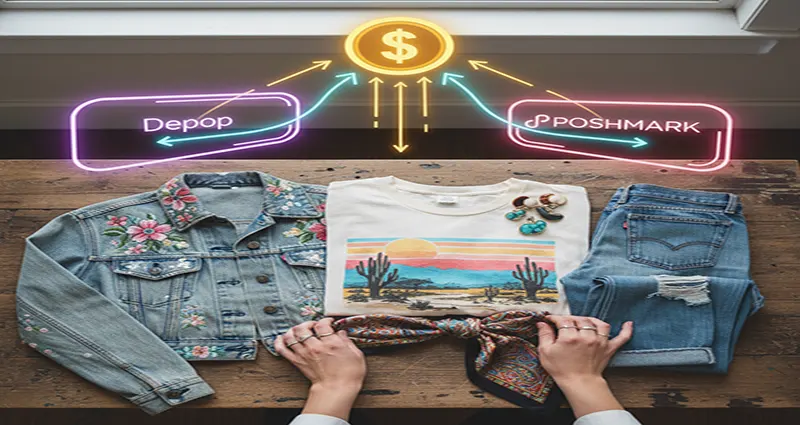The vintage clothing market is booming, transforming thrifting into a viable small business. Yet, success hinges on strategically choosing the right platform for your inventory. While both Depop and Poshmark dominate the re-commerce space, they offer dramatically different audiences, listing aesthetics, and cost structures. Here are expert tips for flipping vintage clothing on Depop vs Poshmark to maximize your sales potential.
Platform Deep Dive: Audience & Aesthetic
Your first decision should be matching your vintage haul to the platform’s core demographic.
- Depop: This platform caters primarily to Gen Z and features a strong emphasis on unique, trend-driven pieces like Y2K, 90s streetwear, and hyper-niche aesthetics (e.g., cottagecore). The listing style is highly visual and editorial, prioritizing high-quality, modeled photos that create a boutique or Instagram-like feed. Success relies on leveraging specific style tags and creating a distinctive seller “vibe.”
- Poshmark: Poshmark attracts a broader demographic, often Millennials and older buyers, who primarily seek recognizable brand names (vintage Levi’s, designer wear) and closet clear-outs. The listing strategy is simpler—clear lay-flats or mannequin shots—focusing on item condition and brand visibility. The platform is highly social, requiring sellers to share listings frequently and participate in “Posh Parties” to boost traffic.
Profitability and Fees
Understanding the cost of doing business is critical for pricing.
- Poshmark Fee Structure: Poshmark employs a simple but higher commission of 20% for sales over $15 (and a flat $2.95 fee for sales under $15). Th6is high percentage is offset by its simple, flat-rate shipping system (paid by the buyer), which includes the label. The flat-rate shipping attracts buyers for heavier or bulkier vintage items, simplifying the seller’s logistics.
- Depop Fee Structure: Depop charges a significantly lower 10% commission on the total sale price (including shipping), plus the standard payment processing fee (typically $\sim 3.3\% + \$0.45$). While the commission is lower, the seller must manage and often pay for or calculate shipping costs separately, adding complexity. Depop is generally more cost-effective for lightweight vintage items where cheaper postal rates can be used.
Actionable Listing Tips
The best strategy is cross-listing your inventory while tailoring the presentation for each audience. Price your items slightly higher on Poshmark to absorb the 20% fee, which buyers expect. On Depop, where the audience is often more budget-conscious, ensure your price is competitive but fully covers the 10% commission, processing fees, and your shipping expenses to avoid losing profit.
On Depop, use strong titles and up to four high-quality, creative photos that capture the item’s aesthetic. On Poshmark, utilize the ability to upload more photos (up to 16) to showcase brand tags and specific measurements, and dedicate time daily to sharing your closet to remain visible.
Ultimately, mastering tips for flipping vintage clothing on Depop vs Poshmark requires a dual strategy. Send your unique, trend-driven pieces to Depop, and reserve your recognized, brand-heavy vintage for the brand-focused Poshmark audience.











